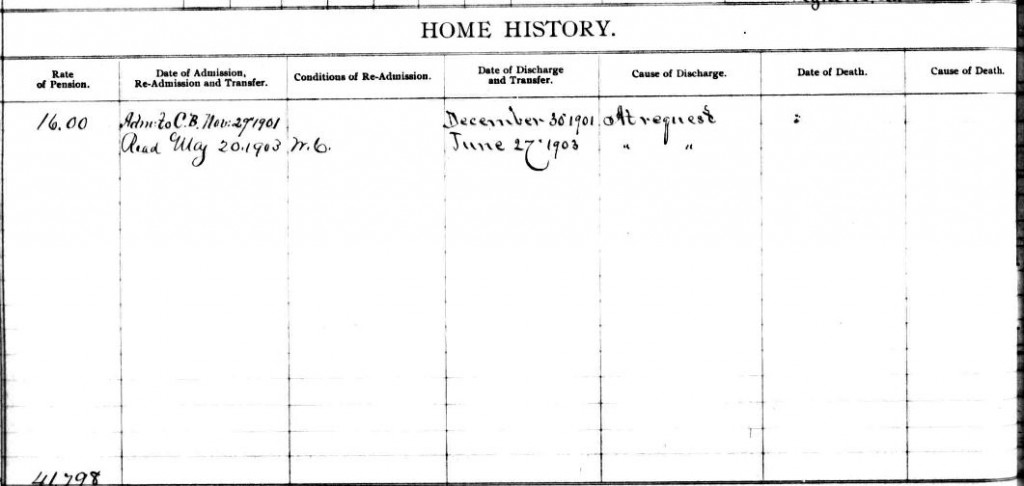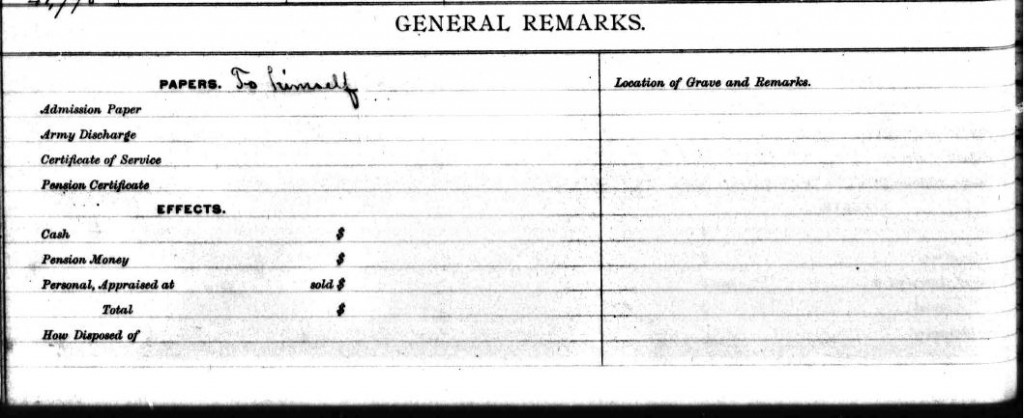Old Soldiers’ Homes
Posted By Norman Gasbarro on May 9, 2012
In March 1865, Pres. Abraham Lincoln signed an act of Congress approving the establishment of the National Home for Disabled Volunteer Soldiers. Initially, three branch homes were established: in Togus, Maine; in Dayton, Ohio; and in Milwaukee, Wisconsin. Eventually, eleven national homes were constructed. Veterans who qualified under the voluntary admission policy only had to show that their service was honorable and their disabilities were incurred as a result of their wartime service.
The homes were run like the military regiments in which the men served in the war; the men wore uniforms and were assigned to companies and bugles were used to call men to meals and organized activities. Also, the homes were set up like small cities complete with schools, churches and hospitals.
A picture post card (above) of the Old Soldiers’ Home at Dayton, Montgomery County, Ohio, shows the extent to which the home had grown by the early part of the twentieth century. Many pictures of these old homes can be found on the web, often on picture post cards, but also actual photographs.
The communal living aspects of Soldiers’ Home life was not for everyone, so veterans or their families could opt out at any time with a voluntary discharge.
The registers of the Soldiers’ Homes that pertain to men who served in the Civil War can be found in a database entitled U.S. National Homes for Disabled Volunteer Soldiers which is available through Ancestry.com. It is fully searchable via the name of the veteran. The records can also be browsed individually for each of twelve homes. These registers usually contain some basic information including the name of the soldier; the date of admission to the home and discharge from the home; the military regiment name, company, rank and date of service; the date and place of enlistment and discharge; a physical description of the veteran [height, complexion, eye and hair color]; occupation; marital status; religion; and “next of kin.”
The data reference citation for the Ancestry.com records is:
Ancestry.com. U.S. National Homes for Disabled Volunteer Soldiers, 1866-1938 [database on-line]. Provo, UT, USA: Ancestry.com Operations Inc, 2007. Original data: Historical Register of National Homes for Disabled Volunteer Soldiers, 1866-1938; (National Archives Microfilm Publication M1749, 282 rolls); Records of the Department of Veterans Affairs, Record Group 15; National Archives, Washington, D.C.
An example of the type of record found in the database is given below. Normally, there are two records per view, but the register page pictured has been cropped to eliminate the “other” veteran and only show the record for Jacob Alvord, who was from Lykens Borough, Dauphin County.
Note: By clicking on the three sections of the above pictured document it will enlarge so it can more easily be read.
One of the interesting things about this record group is that often the veteran explains how and where he received the disability. The record for Jacob Alvord indicates that he received a gun shot wound [“G.S.W.”] at Spotsylvania Court House and lost part of his hand thus impairing its usefulness. During his recovery, he was confined to a hospital in Washington, D.C. At admission to the Old Soldiers’ Home, he complained of chronic rheumatism and was only in “fair” condition.
The home record notes that Jacob’s pension was $16.00 per month at the time of his admission, which first was 29 November 1901. This was followed by a voluntary departure on 30 December 1901 and a second admission on 20 May 1903 and a voluntary departure on 27 June 1903. These two stays, each for about one month, were at the Central Branch Home [“C.B.” in the record] – which was the designation for the home at Dayton, Ohio.
At this time, it is believed that about a dozen or more veterans from the Lykens Valley area were residents at the Dayton Old Soldiers’ Home, but that number could rise significantly as research continues on the more than 2000 men who are included in the Civil War Research Project.
One interesting discovery yet to be explored is that veteran Timothy McDonald is found to have been a resident of six different homes including the home at Dayton, Ohio. Other homes where Timothy resided were in Danville, Indiana; Johnson City, Tennessee; Milwaukee, Wisconsin; Sawtelle (Los Angeles), California; and Hampton, Virginia.
Research also continues into finding the graves of veterans and it has been discovered that often, when the veteran died at one of the Old Soldiers’ Homes, he was buried in the home cemetery. Such was the case with Joseph Louden, who was a resident at Dayton and was buried in Dayton National Cemetery. [Note: see also yesterday’s post, The Grave of Joseph Louden, where pictures of the grave marker were supplied by Sgt. Mark Conrad, the Director of the Miami Valley Military History Museum]
Additional information on the Old Soldiers’ Home at Dayton, Ohio, can be found at the following places:
Carolyn Burns’ Genealogy – Soldiers Home of Dayton, Ohio
Miami Valley Military History Museum – Galleries – Dayton Soldiers’ Home
 ;
;







I just discovered through Joe Rinehart that my great-grandfather, Joseph Legner, was a resident of the Soldiers Home at Dayton, Ohio. He was there on what appears to be two separate occasions. His record is on page 23899 of the Register.
He was a member of the 9th of Ohio Company D. Shortly after McCook was assassinated, Joe suffered two gunshot wounds to his lower right leg while on picket duty near Huntsville (Tenn.?).. His attending surgeon told him he was a mighty lucky young soldier – the shots did not break any bones and appeared to be through and through. It resulted in a limp but he was be to walk with the aid of a cane(the old head of which I have) the rest of his life. His memories of the war as listed on his Soldier Home record included a hernia and “defective hearing.
He was born in Waldernbach Germany in August 1838. His parents brought him an his siblings to Cincinnati in 1857.
His stays at the Soldiers Home were: from June 2, 1897 to Oct. 3, 1898 and again from July 15, 1899 to December 22, 1909. Cause of discharge each time was at his request.